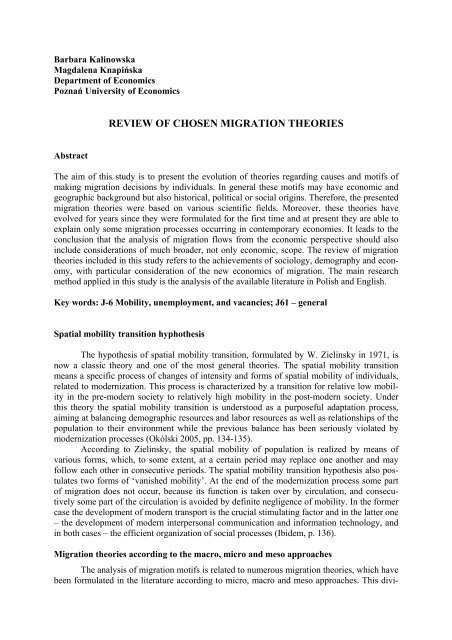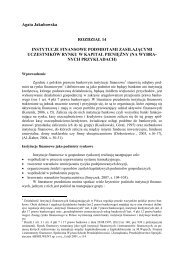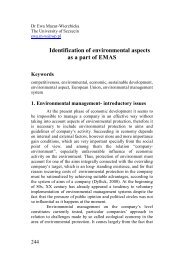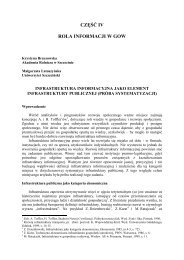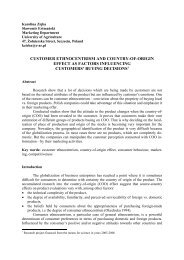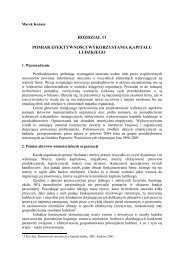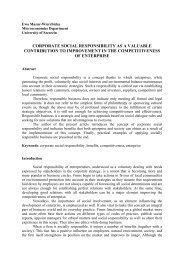REVIEW OF CHOSEN MIGRATION THEORIES
REVIEW OF CHOSEN MIGRATION THEORIES
REVIEW OF CHOSEN MIGRATION THEORIES
You also want an ePaper? Increase the reach of your titles
YUMPU automatically turns print PDFs into web optimized ePapers that Google loves.
Barbara Kalinowska<br />
Magdalena Knapińska<br />
Department of Economics<br />
Poznań University of Economics<br />
<strong>REVIEW</strong> <strong>OF</strong> <strong>CHOSEN</strong> <strong>MIGRATION</strong> <strong>THEORIES</strong><br />
Abstract<br />
The aim of this study is to present the evolution of theories regarding causes and motifs of<br />
making migration decisions by individuals. In general these motifs may have economic and<br />
geographic background but also historical, political or social origins. Therefore, the presented<br />
migration theories were based on various scientific fields. Moreover, these theories have<br />
evolved for years since they were formulated for the first time and at present they are able to<br />
explain only some migration processes occurring in contemporary economies. It leads to the<br />
conclusion that the analysis of migration flows from the economic perspective should also<br />
include considerations of much broader, not only economic, scope. The review of migration<br />
theories included in this study refers to the achievements of sociology, demography and economy,<br />
with particular consideration of the new economics of migration. The main research<br />
method applied in this study is the analysis of the available literature in Polish and English.<br />
Key words: J-6 Mobility, unemployment, and vacancies; J61 – general<br />
Spatial mobility transition hyphothesis<br />
The hypothesis of spatial mobility transition, formulated by W. Zielinsky in 1971, is<br />
now a classic theory and one of the most general theories. The spatial mobility transition<br />
means a specific process of changes of intensity and forms of spatial mobility of individuals,<br />
related to modernization. This process is characterized by a transition for relative low mobility<br />
in the pre-modern society to relatively high mobility in the post-modern society. Under<br />
this theory the spatial mobility transition is understood as a purposeful adaptation process,<br />
aiming at balancing demographic resources and labor resources as well as relationships of the<br />
population to their environment while the previous balance has been seriously violated by<br />
modernization processes (Okólski 2005, pp. 134-135).<br />
According to Zielinsky, the spatial mobility of population is realized by means of<br />
various forms, which, to some extent, at a certain period may replace one another and may<br />
follow each other in consecutive periods. The spatial mobility transition hypothesis also postulates<br />
two forms of ‘vanished mobility’. At the end of the modernization process some part<br />
of migration does not occur, because its function is taken over by circulation, and consecutively<br />
some part of the circulation is avoided by definite negligence of mobility. In the former<br />
case the development of modern transport is the crucial stimulating factor and in the latter one<br />
– the development of modern interpersonal communication and information technology, and<br />
in both cases – the efficient organization of social processes (Ibidem, p. 136).<br />
Migration theories according to the macro, micro and meso approaches<br />
The analysis of migration motifs is related to numerous migration theories, which have<br />
been formulated in the literature according to micro, macro and meso approaches. This divi-
46 Barbara Kalinowska, Magdalena Knapińska<br />
sion was implemented after researchers had realized how complex the issue of causes and<br />
motifs of migration was. The micro approach takes into account a particular values system of<br />
an individual, his or her desires and expectations as well as human resources of migrants.<br />
The macro approach, on the other hand, concentrates on the economic, political and<br />
demographic situation in a particular country. It also includes universal factors applicable on a<br />
particular territory, such as laws, immigration and emigration regulations and global economic<br />
changes.<br />
Finally, the meso approach presents an additional dimension, which is absent in the<br />
two former approaches: the collective and social bonds. Social and symbolic bonds between<br />
an individual and the community influence decisions made by potential and current migrants.<br />
The analysis of mechanisms conditioning departures from a particular country from the meso<br />
perspective is also important due to the fact that majority of immigrants arriving in well developed<br />
countries still come from traditional communities, in which it is the family or local<br />
community that decides upon a departure of an individual, as it provides funds for this departure<br />
(Balicki, Stalker 2006, p. 29).<br />
Micro theories include, among others, the expectancy-value model, the stressthreshold<br />
model, the relative deprivation and relative frustration model and the economic<br />
cost-benefit model. The macro approach models include: the Pioneering Gravity Model and<br />
the ‘push-and-pull’ theory. The fact of combining elements of micro and macro approaches<br />
must also be marked, as it can be noticed in the case of the mixed theory called the ‘push and<br />
pull’ model and the cost-usage theory. On the other hand the meso approach is represented by<br />
the theory defined as the social choice or the new migration economy (Ibidem, pp. 31-40).<br />
Taking into consideration our further analyses migration causes explained by the<br />
macro approach theories seem to be the most interesting (Migration theories review on the basis<br />
of Balicki, Stalker 2006, who performed it on the basis of: Th. Faist (2000), The Volume and Dynamics<br />
of International Migration and Transnational Social Spaces, Clerendon Press, Oxford). The first<br />
theory of this type, called the Pioneering Gravity Model, was formulated already in 1885 by a<br />
British geographer, E.G. Ravenstein (The assumptions of this theory were published in: Ravenstein<br />
(1885), The laws of migration, „Journal of Royal Statistical Society”, no. 2), and it is also called<br />
Ravenstein’s Laws. According to this author migration is mainly caused by economic reasons:<br />
migrants search for better work and financial profits and the number of migrants decreases<br />
as the distance from the destination country increases. Therefore the development of<br />
transport shall lead to increasing migration tendencies.<br />
P. Kaczmarczyk, among others, defines Ravenstein’s laws more precisely while referring<br />
to the article by E. Lee. According to these two authors the first Ravenstein’s law says<br />
that the migration flow volume is the reverse function of the distance, i.e. short distance migrations<br />
are more frequent. Secondly, migration consists of stages which are directed towards<br />
centers of higher and higher level of development, e.g. from the rural areas to the town, then<br />
to other bigger and better developed urban centers, finally outside the boarder of a particular<br />
country. As the third law of Ravenstein the authors mention the rule that each flow generates<br />
a corresponding counter-current. The fourth law says that inhabitants of towns are characterized<br />
by a lower inclination for migration than inhabitants of rural areas and the fifth law says<br />
that women constitute the majority of short distance migrants. The sixth law is given as the<br />
tendency of technology, or technological change, being the migration favoring factor. And<br />
finally the last seventh law of Ravenstein claims that migration is favored by all negative<br />
manifestations of activities of the state, e.g. bad laws, high taxes, as well as improper social<br />
environment or even unattractive climate (Kaczmarczyk 2005, p.29).<br />
E. S. Lee developed further Ravenstein’s Laws by focusing on the migration volume,<br />
migration streams and on the characteristics of the very migrations. E.S. Lee stated that the<br />
volume of migration from a particular territory changes together with the level of diversity of
Review of Chosen Migration Theories 47<br />
area included in territory. Migration volume is also related to the diversity of the prospective<br />
migrants and it also changes depending on changing external conditions. Migration volume<br />
depends also on the situation of the economy itself, although in the long run it has a growing<br />
tendency. Finally, the author claims that the volume of migration depends on the development<br />
level of the country and region which the migrant is going to leave (Lee 1966, pp.47-57, after:<br />
Lewis 1982, p. 21).<br />
Regarding migration streams, E. S. Lee thinks that the better defined they are the bigger<br />
they are. A counter-stream stream develops in relation to the main migration stream. The<br />
migration stream efficiency 1 is high if the major factors in the development of a migration<br />
stream were minus factors at origin. Moreover, E.S. Lee claims that the efficiency of the migration<br />
stream and of the counter-stream stream has a dropping tendency if the departure and<br />
destination regions are similar. The efficiency has a growing tendency if these conditions are<br />
extremely different. According to Lee the migration stream efficiency depends on economic<br />
conditions and is high in prosperous times and low in depression times (Lee 1966, pp.47-57,<br />
after: Lewis 1982, p. 21).<br />
As far as the characteristics of migrants is concerned E.S. Lee claims that migration is<br />
selective. Migrants tend to consider positive factors or pulling factors occurring in the migration<br />
destination place as well as negative factors, which, in a way, ‘push’ them to migrate.<br />
The level of positive selection of the aforementioned factors, i.e. the level of making decisions<br />
about departures, depends on many intermediate factors as well as on the position of the<br />
candidate in his life cycle, which also determines one’s attitude to migration. Moreover, the<br />
characteristics of migrants also depends, which is rather obvious, on the features of societies<br />
of the origin and destination regions (Ibidem, pp. 21-22).<br />
These considerations may be formulated otherwise as the ‘push- and-pull’ theory, according<br />
to which there are factors ‘pushing’ to migration departures and factors ‘pulling’ potential<br />
immigrants. This theory was formulated by E. Lee, who distinguished the following<br />
factors which are taken into account while a decision on migration is being made: factors related<br />
to the place of origin (push factors), factors related to the place of destination (pull factors),<br />
intervening obstacles and personal factors.<br />
The ‘push’ type factors include, in particular, international conflicts, internal military<br />
conflicts, totalitarian regimes, persecutions, compulsory displacements, discrimination of minority,<br />
discrimination of majority, violation of human rights, guerilla activity and terrorism,<br />
poverty and hunger, unemployment and low wages, natural disasters and ecological disasters.<br />
Among the ‘pull’ factors we can distinguish state guarantees of social minimum wages, absorptive<br />
labor market with higher level of wages, educational possibilities or possibilities to<br />
acquire a new job, economic development and growth, joining of families, a chance to<br />
achieve prosperity, political stability, lawful governance and democracy, pluralism, efficient<br />
protection of human rights, life space (Balicki, Stalker 2005, after: Hailbronner 2000, pp. 16-<br />
17).<br />
D. J. Bogue formulated a mixed theory combining elements of the ‘push-and-pull’<br />
theory and the cost-benefit theory and its assumptions are presented in Table 1. A positive<br />
migration departure decision might be made in the event when the influence of factors specified<br />
in Table 1 in sections B and C is stronger than the influence of factors from sections A<br />
and D. If factors from sections A and D have stronger impact than factors from sections B and<br />
C the decision regarding movement is likely to be negative Balicki, Stalker 2005, after Slany<br />
1995, pp. 45-46).<br />
1 The efficiency of the migration stream is defined as the relation of the migration stream and its counter-stream<br />
or as the balance of redistribution of the population affected by the counter-stream. Refer to: Lewis 1982, p. 21.
48 Barbara Kalinowska, Magdalena Knapińska<br />
These issues are treated similarly in the Stouffer’s model, in which migration decisions<br />
also depend on pluses and minuses related to the country of origin, pluses and minuses<br />
of the destination country and also intervening obstacles and personal factors (Sundari 2007,<br />
p.33, after: Stouffer 1940). In each case individuals make a settlement of pluses and minuses<br />
or, in other words, of factors encouraging and discouraging migration related to the country of<br />
origin and to the country of destination and on the basis of this balance they make their decisions<br />
whether to migrate or stay in their own country.<br />
Table 1. Potential costs and benefits of migration<br />
A. Potential costs of leaving a country<br />
Inhibiting factors<br />
• Transport to the new destination<br />
• Uncertainty related with finding a<br />
new work place, and problem of<br />
accommodation while looking for<br />
work<br />
• Costs of living while looking for<br />
work<br />
• Necessity to change external image<br />
(purchase of clothes, personal<br />
hygiene means, etc.)<br />
• Feeling of alienation<br />
• Lack of respect and acceptance in<br />
new environment<br />
• Necessity to know and use a foreign<br />
language<br />
• Necessity to change previous manners<br />
of behavior, habits, likings, etc.<br />
C. Potential costs of staying in a country<br />
Pushing factors<br />
• Difficulties in finding work on the<br />
domestic labor market, lack of<br />
adequate work place corresponding to<br />
ambitions of individuals<br />
• Unsatisfactory social and political<br />
relationships<br />
• Unsatisfactory activities of social and<br />
political institutions of various type<br />
• Violation of basic human rights<br />
• Ethnic, social, political and religious<br />
inequalities<br />
B. Potential benefits of leaving a country<br />
Pulling factors<br />
• Higher wages<br />
• Possibility to choose a work place,<br />
consideration of personal preferences<br />
• Improvement of living conditions<br />
• Possibility to improve the level of<br />
education, a chance of selffulfillment,<br />
raising the level of<br />
ambitions<br />
• Vast possibilities of development and<br />
education of children<br />
• Higher level of services, higher<br />
standard of living<br />
• Attractive social life<br />
• Favorable ethnic, racial, religious,<br />
political and social conditions<br />
D. Potential benefits of staying in a<br />
country<br />
Inhibiting factors<br />
• Cheap already owned dwelling place<br />
(or relative housing stabilization)<br />
• Definite supply of food, relatively<br />
easy living (without the necessity to<br />
change)<br />
• Support of family, direct relationships<br />
with the closest members of family<br />
and social groups<br />
• Living while surrounded by the<br />
closest persons<br />
• Having a definite social status<br />
• Comfort resulting from the possibility<br />
to maintain native tongue, traditions,<br />
customs, ways of dressing, ‘a’ job<br />
provided<br />
Source: K. Slany (1995), Między przymusem a wyborem. Kontynentalne i zamorskie emigracje<br />
z krajów Europy Środkowo-Wschodniej (1939-1989), Rozprawy habilitacyjne no. 295,<br />
Wydawnictwo Uniwersytetu Jagiellońskiego, Kraków, pp. 45-46.
Review of Chosen Migration Theories 49<br />
The newest approaches to migration theories explaining emergence of migration<br />
movements include the approach proposed by T.J. Hatton and J.G. Williamson. According to<br />
them migration is conditioned by, firstly, a gap in per capita income between rich countries<br />
offering high wages and countries in which wages are low. Secondly, it depends on economic<br />
development in the sending country, as it increases the wealth of its citizens and at the same<br />
time it increases the number of people who can afford going abroad. The third factor stimulating<br />
migration is the share of young people in the population – the higher the percentage in<br />
the sending country is, the bigger the migration stream is; on the other hand, a high percentage<br />
of young adults in the receiving country has a negative impact on immigration. Finally,<br />
the fourth migration stimulating factor is the emergence of a network of friends and relatives<br />
in the receiving country, which has a positive impact on the migration stream (Hatton, Williamson<br />
2002, pp. 5-9; Guardia, Pichelmann, 2006, pp. 6-7; Nakonieczna 2007, pp. 17-18).<br />
Migration theories according to migration causes and duration<br />
According to another approach, presented in the Polish literature by K. Iglicka-<br />
Okólska, migration theories may be divided into two groups (Iglicka-Okólska 1998, p. 13,<br />
after: Massey 1988). The first basic group includes these theories which attempt to explain the<br />
causes of international migrations. The other group consists of theories which describe why<br />
migration last in time and space.<br />
Among theories explaining migration causes the most interesting ones include: the<br />
neoclassical economics migration theory, the new economics of migration theory, the dual<br />
labor market theory and the world system and globalization theory). Regarding the other<br />
group of theories it includes such theories as the network theory, the theory of institutions and<br />
the cumulative causation theory.<br />
Diagram 1. Conceptual framework of partial migration theories<br />
Migration theory<br />
Theories explaining migration<br />
causes<br />
Theories explaining migration<br />
duration<br />
Source: K. Iglicka-Okólska, (1998), Analiza zachowań migracyjnych na podstawie wyników<br />
badania etnosondażowego migracji zagranicznych w wybranych regionach Polski w latach<br />
1975-1994, Monografie i Opracowania no. 438, SGH, Warszawa, p. 13.<br />
In the neoclassical migration theory labor markets are the main mechanism causing the<br />
flow of labor force and the other markets do not influence migration. International migration<br />
is caused by geographic differences in demand and supply of work. In countries with large<br />
resources of labor force in relation to their capital (conventionally called the ‘poor countries’)<br />
earnings are lower and in countries with limited human resources in relation to their capital<br />
(conventionally called the ‘rich countries’) earnings are higher. The differences in earnings<br />
cause emigration of workers from the higher earnings countries, which results in dropping<br />
supply of work and consecutive increase of earnings in the poor countries. However, in the
50 Barbara Kalinowska, Magdalena Knapińska<br />
rich countries simultaneously the labor supply grows and earnings tend to decrease – which<br />
leads to a balance (Iglicka-Okólska 1998, p.14).<br />
According to the neoclassic theory, the macro model presented above corresponds<br />
only to the micro model, called the ‘individual choice model’. Its assumption that international<br />
movement is not generated unless there are differences in earnings between particular<br />
countries is identical to the assumption of the macro model. Moreover, it is emphasized in the<br />
micro model that it is the individual who makes the final migration decision, when, as K.<br />
Iglicka-Okólska states, the settlement of costs and profits results in a positive balance. An<br />
individual migrates to the destination where the net profit is the highest (Ibidem, pp. 14-15).<br />
Another author, G. J. Borjas, has formulated the essence of the decision making process<br />
as the following mathematical equation:<br />
where:<br />
ER(0) – net profit from migration calculated before departure at the 0 moment; when ER(0)<br />
is positive then migration takes place, if it is negative – the prospective migrant remains in the<br />
origin country, if it equals 0 the attitude to migration is indifferent.<br />
P 1 (t) – probability of avoiding deportation; if it equals 1 then legal migration takes place, if it<br />
is smaller than 1 – migration is illegal.<br />
P 2 (t) – probability of employment at destination<br />
Y d (t) – earnings if employed at destinations<br />
P 3 (t) – probability of employment in the country of origin<br />
Y 0 (t) – earnings if employed in the country of origin<br />
r – discount factor, the factor reflecting higher use of money earned at present than in the future<br />
t – migration time<br />
C(0) – migration costs (Ibidem, p.15).<br />
This model, defined in the literature as the Todaro model, is based on four assumptions.<br />
Firstly, migrations are stimulated by rational decisions taking into account costs and<br />
benefits of mainly financial nature. Secondly, migration decisions depend more on expected<br />
than actual differentials. Thirdly, probability of employment at destination is related to the<br />
unemployment rate in this region. Fourthly, migration rates in excess of Urban Job opportunity<br />
growth rates are not only possible but rational and even likely in the face of wide urbanrural<br />
expected income differentials. High rates of urban unemployment are therefore inevitable<br />
outcomes of the serious imbalance of economic opportunities between urban and rural<br />
areas of most underdeveloped countries (Sundari 2007, p. 38).<br />
The classical migration micro model has been developed in the theory of the new economics<br />
of migration, in which the migration decisions are made in fact not by separate individuals<br />
but by households in which people act collectively not only to maximize the expected<br />
income but also to minimize risks and weaken limitations related to other markets than the<br />
labor market (Iglicka-Okólska 1998, p. 15). O. Stark argues that relative deprivation plays an<br />
import ant role in migration decisions. These findings from Mexico show that, for international<br />
migration, relatively deprived households are more likely to engage in international<br />
migration than the better-off households. For internal migration the perceived risk of relative<br />
deprivation in the city plays an important role. If the perceived risk is high, migration ceases<br />
to be an effective way for achieving gains with respect to relative deprivation (Stark 1991, p.<br />
140).
Review of Chosen Migration Theories 51<br />
This theory may be classified as the meso theory, as mentioned above, in which the<br />
group of which the prospective migrant is a member of plays the key role in the decision<br />
making process.<br />
According to K. Iglicka-Okólska the conclusion of this theory that attractiveness of<br />
migration may grow if it is perceived by households as a means to overcome capital and market<br />
limitations in investing in economic activity on the local market constitutes a very important<br />
asset, as it implies that economic development in the regions of origin does not have to<br />
inhibit international migrations (Iglicka-Okólska 1998, p. 15).<br />
On the other hand, the theory of the dual labor market proves that migration is caused<br />
by the demand of labor of workers of foreign extraction, which is inborn in modern industrial<br />
societies. M. J. Piore was the most enthusiastic promoter of such an approach to migration,<br />
according to which migration is not caused by push factors in the countries of origin, but by<br />
pull factors in the destination countries. This author mentioned four factors creating demand<br />
of immigration labor force in advanced industrial societies (Ibidem, pp. 16-18):<br />
Firstly, it is the influence of structural inflation, under which the cost of raising wages<br />
of low level workers is higher for the employee than the very cost of these wages, since raising<br />
wages at low positions generates a necessity of raising wages at higher positions in order<br />
to maintain the structure of wages unchanged.<br />
Secondly, motivation is an important factor which makes persons take up employment,<br />
but it also generates serious problems at the bottom of the social ladder of the labor<br />
hierarchy, because jobs at the lowest level of this hierarchy are not prestigious but there are<br />
possibilities and ways to get to higher levels. Employers need workers who perceive the lowest<br />
levels of this hierarchy just as a means to make money, who treat employment just as a<br />
way to obtain income. Immigrants fulfill this need, at least at the beginning of their migration<br />
career.<br />
Thirdly, a factor favoring migrations is the economic duality, i.e. natural duality of<br />
capital and labor, which results in the division of labor markets of advanced industrial<br />
economies into two sectors: capital-intensive and labor-intensive. Employees in the capitalintensive<br />
sector have more stable work places with the best tools, which require high qualifications<br />
and investments in trainings. However, in the labor-intensive sector employees have<br />
unstable work places, in which wages and employment are lowered in recession times; therefore<br />
it is very difficult to find persons willing to be employed in this sector and thus it is necessary<br />
to employ immigrants.<br />
Fourthly, demographic factors and crucial changed in the actual supply of labor force<br />
also play an important role. The problems of motivation and structural inflation together with<br />
the dual character of the market economy generate constant demand of workers willing to<br />
work in unfavorable and unstable conditions, with low wages and slight chances of promotion.<br />
In the past this demand was satisfied by the labor of women and teenagers. At present<br />
the role of the work of women has changed totally and it is not a source of additional minor<br />
earnings but rather an element of professional career and improvement of status and gaining<br />
social prestige. Moreover, the employment age increased remarkably and nowadays the number<br />
of teenagers taking up employment is smaller and smaller, mainly due to the fact that<br />
these persons usually continue their education and gain professional qualifications. Thus the<br />
imbalance between the structural demand of beginning workers and the limited local supply<br />
of such labor force leads to the growth of the long-term increase of the demand of immigrants<br />
(Ibidem, pp. 16-18).<br />
Another international migration theory of the macro level is the globalization theory or<br />
the world system theory created by I. M. Wallerstein. According to this theory migration is<br />
not generated by duality of labor market inside particular national economies but by the<br />
structure of the global market which was developed in the 16 th century and has expanded
52 Barbara Kalinowska, Magdalena Knapińska<br />
since then. In this scheme the penetration of capitalist economies influences peripheral noncapitalist<br />
societies creating mobile populations, eager to migrate abroad. Thus, according to<br />
this theory, migrations are a natural result of disunity of national economies and dislocation of<br />
the production factor (Ibidem, pp 18-19).<br />
I. M. Wallerstein, the creator of this theory, already in the 70s of the 20 th century,<br />
grouped countries of various development level into concentric circles consisting of the core,<br />
semi-periphery and periphery. Migrations are perceived here as a result of domination of<br />
highly developed states, constituting the core, over the less developed states located in the<br />
periphery. Thanks to migrations the core may develop faster resulting in constantly growing<br />
development distance between the core and the peripheries (Janicki 2007, p. 291).<br />
Diagram 2. The network theory and the development of migration processes<br />
Network theory<br />
Migrations grow until the network is so vast in the region of origin that all persons<br />
willing to migrate can do it easily<br />
Volume of migration flows between two countries is not closely related to the<br />
volume of earnings and employment, because thanks to the development of the<br />
network migration costs decrease significantly<br />
When migration become institutionalized together with the development of the<br />
network the becomes gradually independent of the factors which started it<br />
When the network develops less selectively with respect to social and economic<br />
features migrants and more representatively for the community of their origin.<br />
Source: Own study on the basis of: K. Iglicka-Okólska, (1998), Analiza zachowań migracyjnych<br />
na podstawie wyników badania etnosondażowego migracji zagranicznych w wybranych<br />
regionach Polski w latach 1975-1994, Monografie i Opracowania no. 438, SGH, Warszawa,<br />
p. 19.<br />
The network theory is one of the theories explaining migration duration. The network<br />
of migrants is a network of interpersonal relationships, which bind migrants, former migrants<br />
and non-migrants in the country of origin and in the country of destination. The researchers<br />
studying the role of the network in the maintenance of migration in time and space came to<br />
the conclusions presented in Diagram 2.<br />
Another theory belonging to this group, as classified by K. Iglicka-Okólska, the theory<br />
of institutions, is based on the assumption that at the moment the migration process is initiated<br />
a number of private and social institutions and organizations emerge, aiming at satisfying the<br />
demand created by imbalance between a large group of persons who want to reach the rich<br />
countries and a limited number of immigration visas offered by these countries (Iglicka-<br />
Okólska 1998, pp. 19-20).<br />
Finally, another theory which attempts at explaining the migration duration in space<br />
and time is the cumulative causation theory, based on six social and economic factors which
Review of Chosen Migration Theories 53<br />
influence migrations cumulatively. Firstly, people always may migrate not only to improve<br />
their absolute income, but also their relative income. Before the first person migrates the<br />
range of incomes among poor households in a small community is not big, however, after the<br />
migration these incomes start to differ due to cash flows from the emigration country to the<br />
country of origin.<br />
Secondly, it is important for migrants from rural areas to buy land in the country of<br />
origin, as it is perceived as the source of income in retirement times and a symbol of prestige.<br />
This results in falling demand of local farming labor force, which consecutively leads to a<br />
growing migration pressure.<br />
Thirdly, when households of migrants cultivate the soil they are likely to use intensive<br />
production methods. Application of modern production methods in the farms of migrants<br />
leads to the decreasing demand of local labor force, which again favors migration growth.<br />
Fourthly, when migrations become more common among the community, they systematically<br />
cause changes in the system of values and culture, which again increases migration<br />
growth. Although migrants in the initial stages migrate mainly in order to improve their<br />
financial situation, however, the experiences they gain tend to change them.<br />
Fifthly, migrations are a selective process, which initially attracts only relatively well<br />
educated individuals, who are also highly motivated and productive. It results in reduction of<br />
human resources in the regions of origin and its accumulation in the regions of destination,<br />
raising efficiency of labor force in the latter ones and decreasing it in the former ones.<br />
Sixthly, the social label of immigration changes the social definition of work making<br />
some categories of work branded and perceived as improper for the (local) human labor force.<br />
Aversion of the local labor force to these jobs generates an increase of structural demand of<br />
immigrants, which leads to an increase of emigration from the countries of origin (Ibidem, pp.<br />
20-21).<br />
Conclusions<br />
The review of migration theories presented in this study leads to the conclusion that the presented<br />
views can hardly be called theories and it is difficult to speak about a migration science.<br />
The analyses of migration, which led various authors to formulate the aforementioned<br />
concepts regarding migration were rather performed in the context of researches conducted<br />
on the ground of other scientific fields. Modern migration researchers more and more commonly<br />
apply an interdisciplinary approach and use the achievements of such sciences as economics,<br />
sociology, demography, political sciences and history. This leads, however, to a large<br />
diversification of research perspectives, methods and analysis levels of migration phenomena.<br />
Moreover, it may be noticed that the known migration concepts need not be in opposition, on<br />
the contrary – they may complement one another, just like individuals are involved in mobility<br />
due to the profits and loss settlement related to undertaking or neglecting labor migrations.<br />
Therefore, doing a review of theories or concepts on migration causes and results is a fairly<br />
difficult process, in which one may encounter various but, at the same time, complementary<br />
analyses explaining the issues of international migration of the population.<br />
REFERENCES:<br />
1. Balicki J., Stalker P., (2006), Polityka imigracyjna i azylowa, Wydawnictwo Uniwersytetu<br />
Kardynała Stefana Wyszyńskiego, Warszawa.<br />
2. Faist Th., (2000), The Volume and Dynamics of International Migration and Transnational<br />
Social Spaces, Clerendon Press, Oxford.<br />
3. Guardia N.D., Pichelmann K., (2006), Labour Migration Patterns in Europe: Recent
54 Barbara Kalinowska, Magdalena Knapińska<br />
Trends, Future Challenges, Economic Paper no. 256, Directorate-General for Economic<br />
and Financial Affairs, European Commission, Bruksela.<br />
4. Hailbronner K., (2000), Immigration and Asylum Law and Policy of the European Union,<br />
Kluwer Law International, The Hague, London, Boston.<br />
5. Hatton T.J., Williamson G.J., (2002), What fundamentals drive world migration?, Working<br />
Papers no. 9159, National Bureau of Economic Research, Cambridge, pp. 5-9.<br />
6. Iglicka-Okólska K., (1998), Analiza zachowań migracyjnych na podstawie wyników badania<br />
etnosondażowego migracji zagranicznych w wybranych regionach Polski w latach<br />
1975-1994, Monografie i Opracowania no. 438, SGH, Warszawa.<br />
7. Janicki W., (2007), Przegląd teorii migracji ludności, Annales Universitatis Mariae Curie-<br />
Sklodowska, Zakład Geografii Ekonomicznej, INoZ, Vol. LXII/14, Lublin.<br />
8. Kaczmarczyk P., (2005), Migracje zarobkowe Polaków w dobie przemian, Wydawnictwa<br />
Uniwersytetu Warszawskiego, Badania Ekonomiczne, Warszawa.<br />
9. Lee E.S., (1996), A theory of migrations, “Demography”, no. 3, pp. 5-18.<br />
10. Lewis G.J., (1982), Human migration. A geographical Perspective, CROMM HELM,<br />
London&Canberra.<br />
11. Massey D.S., (1988), Theories of International Migration: a Review and Apprasisal,<br />
„Population and Development Review”, Vol. 19, No. 3, pp. 383-414.<br />
12. Nakonieczna J., (2007), Migracje międzynarodowe a rozwój państwa, Żurawia Papers,<br />
Zeszyt 9, Wydawnictwo Naukowe Scholar, Warszawa.<br />
13. Okólski M., (2005), Demografia. Podstawowe pojęcia, procesy i teorie w encyklopedycznym<br />
zarysie, Wydawnictwo Naukowe Scholar, Warszawa.<br />
14. Ravenstein E G., (1885), The laws of migration, „Journal of Royal Statistical Society”<br />
1885, no. 2.<br />
15. Slany K., (1995), Między przymusem a wyborem. Kontynentalne i zamorskie emigracje z<br />
krajów Europy Środkowo-Wschodniej (1939-1989), Rozprawy habilitacyjne no. 295,<br />
Wydawnictwo Uniwersytetu Jagiellońskiego, Kraków.<br />
16. Stark O., (1991), The Migration of Labour, Harvard University Press, Harvard.<br />
17. Stouffer A.S., (1940), Intervening Opportunities: A theory Relating to Migration and<br />
Distance, “American Sociological Review”, no.5(6).<br />
18. Sundari P., (2007), Migrant Women and Urban Labour Market. Concepts and Case Studies<br />
of Problems, Gains and Losses, DEEP&DEEP Publications PVT.LTD, New Delhi.


